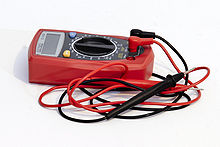Volt
[2] It can be expressed in terms of SI base units (m, kg, s, and A) as Equivalently, it is the potential difference between two points that will impart one joule of energy per coulomb of charge that passes through it.Historically the "conventional" volt, V90, defined in 1987 by the 18th General Conference on Weights and Measures[3] and in use from 1990 to 2019, was implemented using the Josephson effect for exact frequency-to-voltage conversion, combined with the caesium frequency standard.[4] Empirically, several experiments have shown that the method is independent of device design, material, measurement setup, etc., and no correction terms are required in a practical implementation.Ohm's Law is analogous to the Hagen–Poiseuille equation, as both are linear models relating flux and potential in their respective systems.Nominal voltages of familiar sources: In 1800, as the result of a professional disagreement over the galvanic response advocated by Luigi Galvani, Alessandro Volta developed the so-called voltaic pile, a forerunner of the battery, which produced a steady electric current.



Volt (disambiguation)Josephson voltage standardNational Bureau of StandardsUnit systemelectric potentialelectromotive forceAlessandro VoltaSI base unitsvoltageInternational System of Units (SI)conducting wireelectric currentampereenergycoulombOhm's lawweberselectronvoltselementary chargeupper casecommon nounconventionalGeneral Conference on Weights and MeasuresJosephson effectcaesium frequency standardJosephson constantPlanck constant2019 revision of the SIjunctionswater-flow analogycurrentresistorHagen–Poiseuille equationpotentialmultimeterelectrochemical cellbatteryNerve cellresting potentialAAA, AA, C and D cellsalkaline batteryzinc–carbon batteryLiFePO4Cobaltlithium polymerComparison of commercial battery typesTransistor–transistor logicPP3 batteryAutomotive batterymains electricityMains electricity by countryRapid transitthird railList of railway electrification systems25 kV at 50 Hzelectric power transmissionLightningHermann HelmholtzHugo KroneckerThomas Corwin MendenhallHenry VillardLuigi Galvanivoltaic pilesilverLatimer ClarkCharles BrightInternational Electrotechnical Commissioncgs unitsDaniell cellClark cellOrders of magnitude (voltage)Rail traction voltageSI electromagnetism unitsVoltmeterWayback MachineInstitute of Electrical and Electronics EngineersBibcodeSI unitsBase unitscandelakelvinkilogramsecondDerived units with special namesbecquereldegree CelsiusnewtonpascalradiansiemenssievertsteradianOther accepted unitsastronomical unitdaltondecibeldegree of arcelectronvolthectareminuteminute and second of arcConversion of unitsMetric prefixesHistorical definitions of the SI base unitsSystem of units of measurement